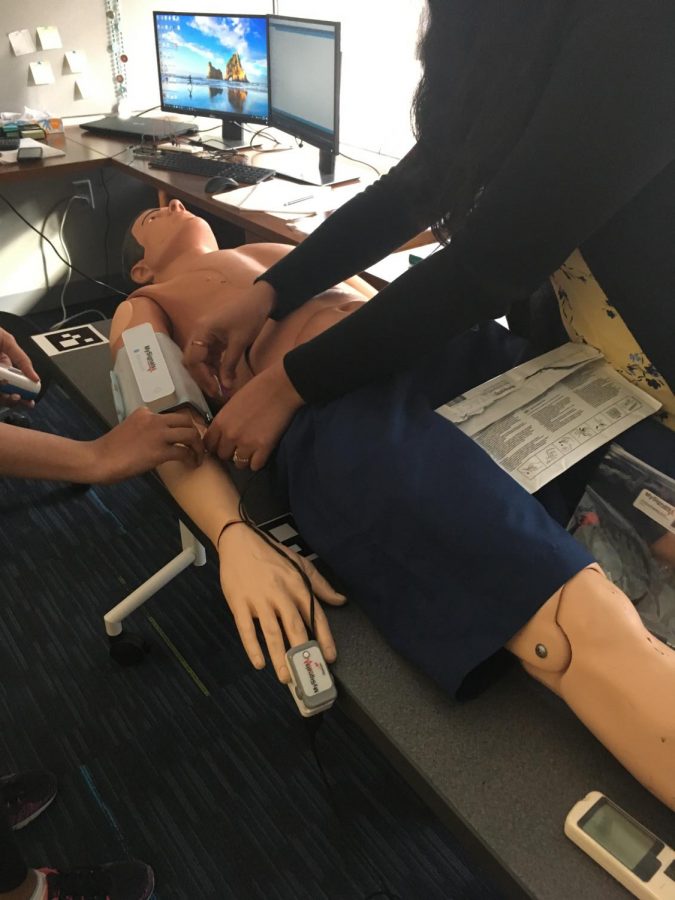Grant aids aging with disabilities
Lab engineers in the Health Care Engineering Systems Center demonstrate sensors that measure patients’ vitals (blood sugar, heart rate, etc) and connect ongoing data to an iCloud system that can be shared with the patients’ doctor on a dummy/mannequin.
November 5, 2018
A group of researchers at the University is working to help those who are aging with disabilities maintain their independence using technologies that are commonly associated with the younger population.
The research is made possible by a five-year, $4.6 million grant from the National Institute of Disability, Independent Living, and Rehabilitation Research and is in collaboration with the Georgia Institute of Technology.
The grant will be put toward research at TechSAge, a University research center focused on the development of advanced technology to promote aging in place, or allowing those independently living in a residence of their choice to stay in that residence for as long as possible.
The research team is led by Wendy Rogers, project director of TechSAge and professor in AHS.
Rogers said while nearly everyone will experience certain health issues that may limit mobility or accessibility as they age, those with pre-existing and permanent health conditions face unique challenges that need to be adequately addressed.
Get The Daily Illini in your inbox!
“As these individuals age, they experience age-related changes in vision, hearing, mobility, cognition and speed of processing,” Rogers said in an email. “They may also have to manage chronic conditions such as hypertension, arthritis, heart disease and diabetes. Consequently, everyday tasks may become more challenging and additional supports may be needed.”
One project is focused on the development of an app that evaluates and mitigates fall risk among elderly populations, which is a huge cause of death and injury, especially among those with pre-existing mobility issues.
“One of the projects actually looks at the ability to use a smartphone to measure fall risk in older adults who utilize wheelchairs,” said Jacob Sosnoff, team member and professor in AHS. “We can use the sensors embedded in the phones during tests to measure their fall risk, and then we make recommendations based on that prediction.”
Sosnoff said most of the projects that are part of the grant involve taking technology that has been designed for younger, healthier populations and making it more usable and accessible for older populations with disabilities.
“Often what happens is technology is used and made for younger generations, and we inadvertently leave people out of using it, so we’re trying to overcome those barriers and make sure that the technology people develop and design is suitable for a wide range of people,” Sosnoff said.
Another member of the research team is Kesh Kesavadas, professor in Engineering and director of the Health Care Engineering Systems Center.
“The center’s interest is looking at voice-activated systems and social robots to help those with disabilities who are hoping to continue independent living,” Kesavadas said.
One of Kesavadas’ main projects is a sensor system that connects patients’ vitals, such as blood sugar levels and heart rates, to an iPad, allowing them to be easily tracked and read by patients and their doctor. He said the projects are able to bring ideas on modern usability and accessibility to life.
“While people on the public health side are more interested in usability, like how people use technology and how they would adjust to more innovation, people in engineering and controls are more interested in what algorithms and data can get systems to work and to be intelligent and safe,” Kesavadas said.
The researchers from the team are spread across multiple disciplines, with professors collaborating from the fields of engineering, computer science, biostatistics, kinesiology and community health to address different accessibility concerns.
Rogers said research naturally becomes more well-rounded with a team that can bring multiple perspectives to the table.
“The kinesiology and community health members of the team take a person-centered focus in the design,” Rogers said. “This perspective complements the engineers’ focus on the device, product, or system characteristics. This results in a strong interdisciplinary approach in our research and development efforts.”
Sosnoff shared Rogers’ view on the importance of interdisciplinary research.
“Something I tell my students often is, more or less, all the simple projects have gotten solved, so just having basic knowledge of our own field isn’t going to solve the problem,” Sosnoff said. “We need to work with these experts in engineering and computer science to better inform our research and give it greater impact.”
Despite the groundbreaking work that will be performed at the center, Rogers said there will still be work to be done in the future to provide more accessibility to this specific demographic.
“Our initial research suggests that this segment of the population continues to face challenges in their everyday activities,” Rogers said. “Ideally in 10 years we will have made advancements in accessibility that enable aging in place and full participation in society for everyone.”







